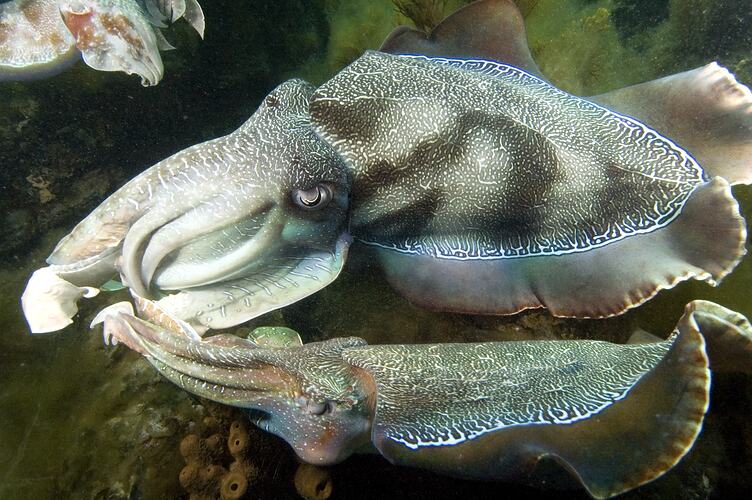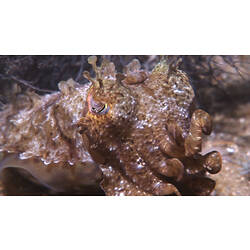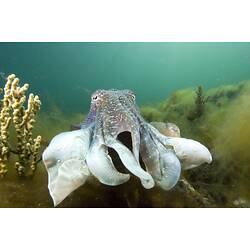General Description
A large, robust cuttlefish (the world's largest). Recognised by triple flaps of skin above each eye. Cuttlebone of larger animals without spine; instead possessing a wide shelf-like flange around the rear tip. Males possess wide banner-like webs off lower arm pair. Males can attain a total length of 1 m and a mantle length and cuttlebone length to 50 cm. Females are generally smaller than males.
Biology
The Giant Australian Cuttlefish is the largest cuttlefish in the world. They are excellent at camouflage and can push up branched flaps of skin all over their body that help them stalk their prey while hiding from predators such as dolphins, seals, sharks and other large fishes. This species is generally day active but individuals have been observed feeding at night. Buoyancy is maintained by the gas-filled internal cuttlebone. The chalky, white cuttlebone of deceased cuttlefish can often be seen floating on the sea surface and regularly wash up on ocean beaches. Females lay large numbers of large white eggs, with pointed tails, deep in crevices. Eggs take several months to hatch.
Distribution
Southern Australia from Moreton Bay Queensland (possible as far north as Shoalwater Bay Queensland) to Point Cloates Western Australia. Lord Howe and Norfolk Islands. All Victorian coastal waters.
Habitat
Rocky reefs, kelp forests and seagrass meadows to a depth of 100 m.
More Information
-
Animal Type
-
Animal SubType
-
Brief Id
A very large squid with 10 arms and tentacles, 3 flaps of skin above each eye. The cuttlebone of larger animals has a shelf-like rim round the rear tip.
-
Maximum Size
50 cm
-
Habitats
-
Diet
Carnivore
-
Hazards
Cuttlefish may bite if harassed or handled. As the existence and chemical composition of venom in this species has not been determined, direct contact should be avoided.
-
Endemicity
-
Commercial
Yes
-
Conservation Statuses
CITES: Not listed, FFG Threatened List: Not listed, DSE Advisory List: Not listed, IUCN Red List: Near Threatened
-
Depths
Shallow (1-30 m), Deep ( > 30 m)
-
Water Column Locations
On or near seafloor
-
Taxon Name
-
Scientific Author
Gray, 1849
-
Common Name
Giant Australian Cuttlefish
-
Other Names
Giant Cuttlefish
-
Phylum
-
Class
-
Subclass
-
Order
-
Family
-
Genus
-
Species Name
apama





